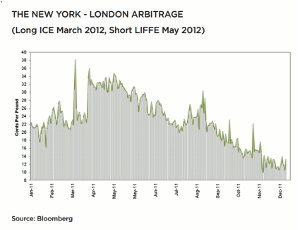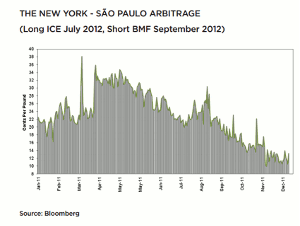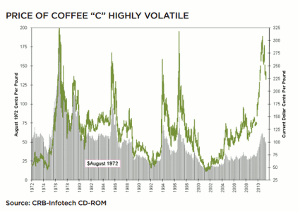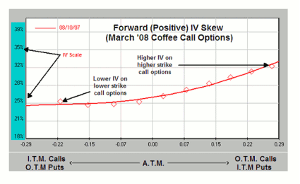Shobhit Seth, at Investopedia.com, explains the differences between trading coffee options and other popular options, the factors that impact the price of coffee, and the risks involved.
Soft commodities, which include cotton, cocoa, coffee, and sugar, are appearing in portfolios as an alternate class of trading assets. Though many other agricultural produce like orange juice, sugar, and cotton enjoy the benefit of subsidies at the regional, national, and international levels, facilitating their trade, coffee production and export do not enjoy the same number of subsidizations for international trade. So while it is the world’s favorite drink, coffee is challenging to trade and price.
Coffee futures have been in existence since 1882 on the New York Cocoa Exchange. The present day center for futures and options trading for coffee contracts is the ICE Futures US exchange.
How Are Coffee Options Different?
While other popular options (that have stocks or indices as the underlying) allow the option buyer to (theoretically) purchase the underlying stock, coffee options have coffee futures as their underlying. Exercising an in-the-money (ITM) coffee call/put option leads the buyer to a long/short coffee futures contract, which he can then square off at market price or rollover as desired.
Let’s start with a simple example on how different participants can use coffee options to their benefit. (For simplicity, we will assume one unit of coffee for each transaction.)
Assume it is January and coffee is currently trading at 155 cents per unit (spot price). A coffee plantation owner expects his crop (one unit of coffee) to be ready for sale by July. Worried about potential coffee price declines, he wants downside protection (a minimum price, say around 145) for when his crop is ready in July. Buying a coffee put option with a strike price of 155 cents expiring in July, currently trading at 9.3 cents, can help. It will give him the right, but not the obligation, to take a short futures position in July coffee C futures at the pre-determined net price of 155 cents per the terms of the option contract. If the put option expires in-the-money, he will be guaranteed a net sale price of 155 cents – 9.3 cents = 145.7 cents. Even if the spot price of coffee in July goes below the earlier set target of 145 (say to 125), the owner has the required price protection that comes from the futures contract he can enter into.
Since the coffee price has declined to 125, the put with the 155 exercise price is in-the-money for the buyer. He exercises the put option to get into the underlying short futures contract that allows him to benefit by 30 cents (155-125). Since he paid 9.3 as option premium, his net profit will be 20.7 cents for one unit of coffee. He sells his actual coffee produce at spot price of 125 cents. Net received = 125+20.7 = 145.07 cents, allowing him to receive his desired sale price of around 145.
Instead, if the coffee price rises to say 180 cents, the put option would become out-of-the-money and buyer would allow it to expire worthless. He would instead benefit by selling the coffee at the spot price of 180 cents. Deducting the loss of 9.3 cents he spent for buying put options, his net sale price is 170.7 cents, well above the expected price of 145 cents. In both cases, he achieves his desired protection.
NEXT PAGE: Why Should I Buy Coffee Options?
|pagebreak|On the other side, a coffee roaster who expects to purchase coffee in July may wish to limit the buy price, to say around 165 cents. He can buy a coffee call option at the strike price of 155 cents by paying an option premium of 9.3 cents. If the price of coffee declines to 125 by July, his call option will expire worthless. But he could benefit by buying coffee at the spot rate of 125 cents. Adding the 9.3 cents price he paid for call options, his net cost comes to 134.3 cents.
If the price increases to 180 cents, he would exercise his call option, which would give him a long futures contract at 155 cents. Selling the futures contract would give him 180 cents, which he actually bought for 155 cents per the terms of option contract. His benefit from the option is 15.7 cents (180-155-9.3). He will buy the coffee at spot rates of 180, taking his net price to 180-15.7 = 164.3 cents, which achieves his set goal of keeping the buy price within his desired limits.
How Many Coffee Call/Put Option Contracts to Buy?
One Arabic coffee ‘C’ contract comprises of 37,500 pounds of coffee. Buying one option contract costing 9.3 cents results in a total option premium of 9.3 cents * 37,500 pounds = $3,487.5. This will provide coverage for 37,500 pounds (=18.75 tons) of coffee production (by harvester) and consumption (by roaster). The number of contracts can be computed, factoring in expected production or purchase requirements.
Why Coffee Options?
Ideally, either futures or options can be used. However, the clear advantage long options have over futures is that long option positions don’t need margin money or a daily mark-to-market like futures. This convenience comes at the cost of a non-refundable option premium paid upfront and it is prone to time decay. Short options require similar margin capital to futures.
Long options also limit the losses (capped to the option premium paid), while futures have unlimited loss potential on both long and short positions.
Market Profile
There are three main markets of coffee: New York (USA), London (UK), and Sao Paulo (Brazil). There are many arbitrage opportunities between these markets, enabling market makers, speculators, and hedgers to keep the coffee market liquid and constantly moving.
Intercontinental Exchange (ICE) provides the following graphs illustrating the arbitrage potential between the top three coffee markets.
Coffee producers, exporters, trade houses, importers, and roasters actively trade coffee options and futures. In addition, speculators, managed funds, institutional and individual investors are also in the coffee markets. The ICE Futures US exchange is the primary platform for world coffee trading, facilitating price discovery, hedging, and trading activities. The ICE exchange has coffee ‘C’ and robusta coffee options available for trading in New York, London, and Singapore, ideally covering all geographical locations across Asia, Europe, and the US during a 24-hour cycle.
Factors Impacting Price
There are two main varieties of coffee on which futures and options are available: robusta and arabica. Brazil, Vietnam, and Columbia remain the top three exporters of coffee, while the European Union, US, and Japan are the top three coffee importers. A variety of reports are available that estimate coffee production and consumption in the US and globally. The report from the US Department of Agriculture or general news reports from market data providers like Bloomberg are good sources.
NEXT PAGE: More Factors in Play
|pagebreak|Most producers are emerging or poor economies, while the largest consumer nations are wealthy. The national incomes of a few small producers like Honduras, Guatemala, and Ethiopia are significantly dependent upon coffee production and exports. Any changes to coffee prices or trading have great impacts and the reactions of these countries, in turn, impact the international coffee market. These changes are cyclical. For example, if coffee prices decline this season, farmers may switch to other crops, leading to a smaller supply of coffee for the next season, resulting in higher prices.
No commodity is shielded from seasonal impacts. For coffee, consumption shoots up during the winter, which may lead to an increase in prices. The largest producer of coffee, Brazil, usually experiences a frost season from May to August. Hence, prices rise in anticipation during the early months of the year. While some of these effects are mitigated by proper storage and more diversified production of coffee across geographies, it is advisable to keep a close eye on such seasonal impacts.
Any development in coffee exporting nations (such as weather effects, geopolitical developments, or an increase in domestic consumption) can result in changes in supply and production.
Historical and Recent Instances Include:
- Recovery after the Brazilian frost of 1953 led to enhanced production, which led to declining coffee prices.
- Another frost in 1975 and the drought of 1985 in Brazil led to a sharp price increases amid falling production.
- The collapse of the International Commodity Agreement in 1989 between coffee producers and consumers, led the sharp decline in coffee prices within a month’s time.
- Recent reports from Bloomberg suggest that domestic consumption in top coffee producing countries like Vietnam is expected to rise, which will lead to lower exports and an increase in prices.
In addition, an interesting study by the International Food and Agribusiness Management Association reveals that soda consumption in the US has a positive impact on coffee prices, while tea consumption leads to a negative impact.
One important parameter while valuing options is the volatility. The ICE provides the following graph, showing the high volatility of coffee prices over the years (as sourced from CRB InfoTech CD):
It is clear that the long-term volatility in coffee prices is very high. The same trend is visible for intra-day price moves in coffee trading. A high level of volatility skew is clearly visible for coffee options. Here is a snapshot:
Coffee options qualify for trading ratio spreads, due to such high variations in volatility between in-the-money, at-the-money, and out-of-the-money options. Historical data during June-July of 1996 and similar patterns of shorter magnitudes create many profitable trading opportunities for ratio spread strategies. While such high variations in volatility provide ample profitable trading opportunities, they also indicate a high level of risk.
The Bottom Line
While trading soft commodities, precious metals, and similar securities sounds exciting and seems profitable, risk remains. Most of these commodities are traded through derivative contracts that have complex structures and challenges in fair pricing. Traders should perform their due diligence, develop sufficient knowledge about market dynamics, and only then trade in such markets.
By Shobhit Seth, Contributor, Investopedia.com

























